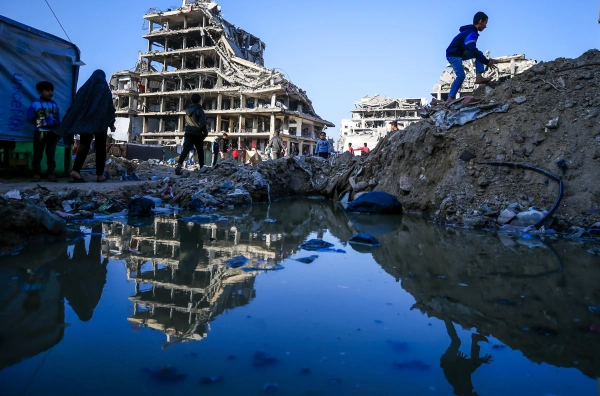
Finally, Israel and Hamas have come to an arrangement — of sorts. On Wednesday night, President Donald Trump stated that the warring groups in Gaza consented to put into practice the “initial stage” of the peace proposal he introduced in September. Even though this doesn’t entirely suggest the war is fully resolved as of now, it seems to be a sincere endeavor by Israel and Hamas to commence bringing to a close two years of brutal struggle, devastation, and grief.
Throughout the course of two years of conflict — set in motion after Hamas stormed Israel and killed approximately 1,200 individuals, the majority of whom were civilians, and abducted nearly 250 others as captives back to Gaza on October 7, 2023 — Israel has decimated the Gaza Strip. It has taken the lives of in excess of 67,000 Palestinians, left starving and uprooted the majority of Gaza’s 2 million inhabitants, and reduced much of the territory’s constructions and substructure to debris.
The predicament of the captives has likewise tormented Israel’s citizenry, compelling many of its inhabitants to participate in extensive demonstrations petitioning for a pact to terminate the war and restore those abducted for over a year. On a global scale, Israel’s actions have left its standing in ruins, its figureheads accused of war offenses by the International Criminal Court and isolated on the global platform by virtually all excluding its closest confederate, the United States. The war, alongside its unpopularity internationally, prompted Israel’s former allies Australia, Belgium, Britain, Canada, France, and Portugal to recognize Palestinian sovereignty at the UN General Assembly last month.
Now we shall determine if the peace can endure, and if it can, what the “subsequent period” essentially resembles. Wednesday’s agreement implies, according to the parties, that every Israeli captive who remains detained in Gaza will be sent back, starting with those still alive, approximated to be around 20 individuals, as early as Monday; the physical remains of the deceased Israeli captives (around 30) will apparently be given back in stages afterward. In return Israel will free nearly 2,000 Palestinian detainees, roughly 1,700 of whom were seized throughout the current clash. Israel likewise conveys that its military will pull back to a mutually decided upon boundary in Gaza as the initial element of its departure from the region.
Related
- Trump’s arrangement might represent a triumph for Netanyahu, regardless of its success or failure.
- Israel is exporting its established Gaza blueprint.
Nevertheless, predominantly, a considerable amount remains obscure regarding the stipulations of the accord that Israel and Hamas have reached. We lack knowledge of whether Hamas has consented to entirely disarm. Additionally, we lack knowledge of the extent to which Israeli forces are pulling out of Gaza, or the schedule of that departure. Israeli Prime Minister Benjamin Netanyahu’s governing body is convening Thursday to vote on endorsing the arrangement, and the ceasefire has not yet commenced; Israeli bombardments on the Strip were reported even as celebrations spread throughout both Gaza and Israel.
This is not an arrangement that Netanyahu’s administration would have approved independently. Indeed, he was reportedly required to be intensely pressured by Trump into agreeing to it.
Still, it’s nearly as close to an outright triumph for Israel as was imaginable throughout the previous two years. Assuming the actual implementation of the arrangement somewhat mirrors what was initially declared by Trump at the start of the month, Israel will maintain a military presence in Gaza alongside the ability to periodically launch ensuing attacks against insurgents there. Hamas will not govern Gaza, nor — for the near future — will the Palestinian Authority. It appears highly probable that external entities, separate from Israel, will be responsible for funding the restoration of Gaza. The seemingly insurmountable quandaries confronted by the Netanyahu administration turned out not to be quandaries whatsoever.
Inferences will be extracted from this, by both Israel and the remainder of the world. The magnitude and absoluteness of its operation, together with their apparent triumph in attaining practically all of the war’s objectives, might guide the nation, in addition to other militaries, toward some exceedingly somber conclusions regarding the optimal means to confront internal dangers from militant factions akin to Hamas going forward.
A notable setback to “counterinsurgency”
It was evident from the very beginning that given the atrocities of October 7, this was destined to be a distinct style of war than those — costly for Gaza’s inhabitants, while restricted in expanse and length — that Israel waged in the region in 2006, 2008, and 2014. The epoch of “trimming the weeds” — impairing Hamas’s proficiencies without getting enmeshed in a lengthy and costly battle to eradicate the group entirely — was patently concluded.
Were Israel to endeavor to bring an end to Hamas completely, global observers furnished proposals. David Petraeus, former commander of US forces in Iraq and Afghanistan, recorded in 2024 that Israel was reiterating America’s post-9/11 missteps by going to war in Gaza devoid of a strategy for a post-war governance framework for the territory. However, he suggested, Israel ought to gain knowledge from the relative accomplishment of the counterinsurgency approaches the US employed in Iraq following 2007.
The genuine consequence of this dispute is apt to become apparent solely when those future conflicts emerge.
“Eliminating and detaining terrorists and insurgents is inadequate,” Petraeus documented in Foreign Affairs back then. “The key to solidifying security advancements and curbing the recruitment of novel adversaries consists of possessing territory, safeguarding civilians, and furnishing governance and services to them.”
This is unmistakably not what Israel undertook. Commanders diminished defenses intended to shield noncombatants. According to specific accounts, upwards of 80 percent of those killed in Gaza might have been noncombatants, substantially elevated in contrast to other recent disputes. Beyond 70 percent of Gaza’s edifices were demolished. Sustenance relief was, at times, obstructed entirely.
Israel was consistently censured all through the war, notably by the Biden administration, for lacking a post-war governance blueprint for Gaza. On the other hand, ultimately, it simply persisted in fighting until one was conceived by external entities, conspicuously the US, that it deemed more satisfactory than prior blueprints.
It comes across as probable that the war is poised to deal a considerable setback to the notion of “counterinsurgency” doctrine: that the optimal means to tackle an insurgency encompasses winning over the local populace — to “clear, hold, and build” your way to triumph. Israelis may perhaps underscore that even though the 466 soldiers they shed in combat is an extremely heightened digit contrasted with other Israeli wars, it’s approximately half of America’s losses in the initial year of Petraeus’s “surge” in Iraq.
Israel waged a war so merciless it was determined to have perpetrated genocide by a UN commission along with prominent international scholars; its prime minister is facing indictment by the International Criminal Court. Furthermore, it concludes the war, mainly on its individual terms, in a deal touted as a “GREAT DAY” by the president of the United States and wholly endorsed by Arab governments.
In essence, Israel’s overwhelming-force strategy — virtually the converse of Petraeus’s philosophy — was substantially successful in the detached terms of accomplishing its objectives. Be that as it may, of course, there exist caveats. Israel has deepened its political estrangement, and while some of that might diminish once the war comes to an end, other portions of it will not. As Yaroslav Trofimov of the Wall Street Journal documents, progressively, “solidarity with the Palestinian cause—and hostility to Zionism—have become the political markers of a new generation.” The comprehensive scope of the aftermath for Israel might not be self-evident for years. Israel’s association with the United States is likewise an exception to the standard: to articulate it plainly, there aren’t numerous nations that could wage war in this manner and persist in obtaining billions of dollars per annum in military assistance. Regardless of Hamas’s eventual destiny, it’s challenging to envision numerous Gazans harboring a more favorable attitude toward Israel at the close of this war than at its inception. It’s not challenging to envision a novel armed resistance movement materializing and executing subsequent attacks on Israel.
And yet, other nations are apt to draw the inference that overpowering the adversary merits the international condemnation that goes along with considerable noncombatant casualties. As a selection of commentators articulated when deliberating US and Israeli bombardments on Iran, former US Secretary of State Colin Powell’s “Pottery Barn rule,” which stipulates that when it pertains to employing military might, “if you break it, you own it,” appears to no longer be relevant. When it comes to overpowering a counterinsurgency, you’re not compelled to “clear, hold, build.” You can simply crush.
This comes across as yet another indication that we have progressed beyond the norms of the post-9/11 “war on terror” epoch — but not toward a more compassionate or lawful modality of warfare. Instead, Gaza may potentially come to be perceived as the inaugural counterinsurgency war of the post-“liberal international order” era — wherein global institutions are feebler and standards encircling the laws of war, democracy, and human rights are withering.
The approaching days will reveal whether this is solely a captive exchange and foreword to a fresh phase of the dispute, or a durable peace. Supposing it’s the latter, it will constitute welcome alleviation for Palestinians and grant prospects for additional desperately needed aid to reach Gaza, in addition to for the inhabitants to commence rebuilding. Israel will be required to grapple with the shortcomings, military as well as political, that precipitated the October 7 attacks as it advances into what could be a closely contested national election in the coming year.
However, the authentic consequence of this dispute is apt to become apparent solely when those future conflicts break out. When questioned regarding the manner in which they conduct those wars, governments are apt to point to Israel’s illustration.
Source: vox.com






